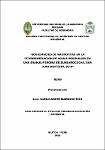Dos especies de Macrofitas en la Fitorremediación de aguas residuales en una granja porcina de Zungarococha, San Juan Bautista, 2018
Abstract
El experimento se desarrolló en la ciudad Universitaria UNAP en Zungarococha, Provincia de Maynas, Distrito de San Juan Bautista, donde se utilizó agua residual procedente de proyecto porcinos de la Facultad de Agronomía, con dos especies de macrófitas flotantes: Azolla caroliniana y Azolla filiculoides, con seis repeticiones. Se registraron datos de la muestra inicial antes del inicio del experimento, a los 90 días y a los 120 días.
Se concluye que el pH, Sólidos Totales, Sales Disueltas en mg/L de muestras de agua residual a los 90 días, no presentan diferencias estadísticas entre las medianas de las variables mencionadas, siendo los efectos estadísticamente iguales. En el caso de Sólidos Suspendidos y Sólidos sedimentables muestran diferencias estadísticas significativas entre las medias de los tratamientos, diferencias de efectos, siendo la media del T1 (A. caroliniana) mayor que el T2 (A. filiculoides). En cuanto a la DBO5 a los 90 días, se observan diferencias estadísticas significativas, del mismo modo estas diferencias son significativas para la variable Nitrógeno Amoniacal, con una confianza del 95%, no siendo así para la variable Fósforo total, que no mostró diferencias estadísticas significativas entre las medias de los tratamientos.
En cuanto a las muestras a 120 días, las variables: Sólidos Totales, Sales Totales Disueltas, Sólidos Suspendidos, Solidos Sedimentables, DBO5 y Fósforo total, no reportaron diferencias estadísticas significativas entre las medias de los tratamientos en estudio. The experiment was carried out in the University City UNAP in Zungarococha, Province of Maynas, District of San Juan Bautista, where residual water from pigs project of the Faculty of Agronomy was used, with two species of floating macrophytes: Azolla caroliniana and Azolla filiculoides, with six repetitions. Data from the initial sample were recorded before the start of the experiment, at 90 days and at 120 days.
It is concluded that the pH, Total Solids, Dissolved Salts in mg / L of residual water samples at 90 days, do not present statistical differences between the medians of the mentioned variables, being the effects statistically equal. In the case of suspended solids and settleable solids show significant statistical differences between the means of the treatments, differences of effects, being the average of the T1 (A. caroliniana) greater than the T2 (A. filiculoides). Regarding the BOD5 at 90 days, significant statistical differences are observed, similarly these differences are significant for the variable Ammoniacal Nitrogen, with a confidence of 95%, not being so for the variable Total Phosphorus, which did not show statistical differences significant among the means of the treatments.
As for the samples at 120 days, the variables: Total Solids, Dissolved Total Salts, Suspended Solids, Sedimentable Solids, BOD5 and Total Phosphorus, did not report significant statistical differences between the means of the treatments under study.
Collections
- Tesis [501]
The following license files are associated with this item:


